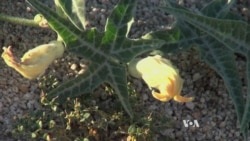A flash of yellow catches Heather-Rose Kates’ eye as she drives the highway running through California’s Mojave Desert. She’s scanning the roadsides for a plant that may help secure the future of some of the world’s favorite vegetables.
“They’re yellow and they’re bigger than tennis balls,” she said, eyeing the highway shoulders. “So they’re kind-of easy to spot.”
Easy if, like Kates, you’ve been driving desert highways for nearly two weeks. To a newcomer, it’s all a stark, beautiful blur. The wide-open roads out here run straight as an arrow through flat plains of scrub and cacti, between barren, gray-brown hills.
The occasional car whizzes by. “Everyone passes us because we’re looking for squash,” Kates said.
A squash called coyote melon, to be specific. It’s a wild relative of butternut squash and pumpkins. Cucumbers, cantaloupes and many other popular fruits and vegetables are also part of the botanical family. There’s a cousin in just about every cuisine in the world.
But Kates definitely is not collecting the coyote melon for its flavor.
“Terrible. It tastes like soap,” she said. And it’s bitter. Really bitter. It’s loaded with cucurbitacin, a chemical that humans bred out of most domesticated relatives of the coyote squash.
Raised in the Wild
What coyote melon lacks in flavor, however, it makes up for in its tolerance for drought. While cultivated squash need about 3 centimeters of water per week, this desert gourd gets by on about 18 centimeters per year. Breeding wild coyote melon with its farmed relations could make some of our favorite vegetables more drought tolerant.
That could be useful in the coming years. On a planet growing hotter, the risk of drought is growing for farmers in certain regions.
“The world is facing a real challenge in terms of food security over the next few decades,” said Andy Jarvis, who heads a climate change and agriculture program at the International Center for Tropical Agriculture.
As the population grows in size and wealth, farmers will need to produce 50 to 70 percent more food by 2050.
“And to be honest, we’re running out of options in terms of making crops more productive,” Jarvis added. “And so, really what I think we’ve got to do is go back to the wild. Go back to the origins to look for characteristics that we can use to improve our crops.”
Life in the wild is a lot tougher than the coddled existence on the farm, Jarvis said.
“These things are exposed. They haven’t had the luxury of pesticides and fungicides and so on,” Jarvis said. “They’re out there battling these things constantly,” which gives some wild relatives “very impressive resistance to a lot of the major pests and diseases.”
Farmers today are growing sunflowers that can handle salty soil thanks to traits bred in from untamed relations, Jarvis said. Corn plants get help fending off rootworms from their wild cousins.
Vanishing plants
There’s a problem, though. Many of the wild relatives are disappearing.
“Our agriculture is dependent on these kinds of species that in the wild are going extinct,” Jarvis said. “They’re threatened, and in most cases we don’t have seed collections in gene banks.”
Kates is part of a global effort to collect as many seeds as possible, while they are still available. Local people in Uganda, Vietnam and elsewhere are also being taught to find and save these precious plants.
They’re collecting wild oats in Cyprus. Wild potatoes in Argentina. Wild chili peppers in Paraguay.
"Careful with those chilies, " Jarvis said. “You have to handle them with gloves. Literally, after being near these things you have to wash your hands pretty thoroughly. Your eyes are red. These are serious business, some of these wild chilies.” In Colombia, they call them “devils,” he added.
The seeds will be stored at the Global Seed Vault in Norway and at Kew Gardens outside London.
But for Kates, the road trip has given her a whole new appreciation of her subjects. She spends most of her time in a lab studying how our food crops got domesticated. But, Kates, noted, “It’s really only once you’re out here looking at the wild plants, which are where our crops came from, that you get to see what they can do.”
And what they might do for our crops in the future.







